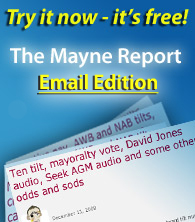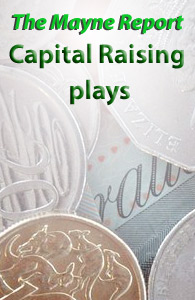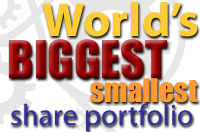Macquarie Airports AGM, Rio audio files, conflicted directors, CEOs on boards, Rich List and big documents
February 2, 2010
Dear Mayne Reporters,
the plane to Sydney for the Macquarie Airports leaves in 9 hours so apologies for the brief introduction to this edition but do click through as there's plenty of food for thought as we set the scene for tomorrow's Millionaire Factory showdown, slate the conflicted St George Bank chairman, reveal some enlightening Rio Tinto AGM audio and produce three new or updated lists.
Also, check our the home page for some other stuff I've been up to lately, including this new video.
Do ya best, Stephen Mayne
* The Mayne Report is a multi-media governance website published by Stephen Mayne with occasional email editions. To unsubscribe from the emails click here.
the plane to Sydney for the Macquarie Airports leaves in 9 hours so apologies for the brief introduction to this edition but do click through as there's plenty of food for thought as we set the scene for tomorrow's Millionaire Factory showdown, slate the conflicted St George Bank chairman, reveal some enlightening Rio Tinto AGM audio and produce three new or updated lists.
Also, check our the home page for some other stuff I've been up to lately, including this new video.
Do ya best, Stephen Mayne
* The Mayne Report is a multi-media governance website published by Stephen Mayne with occasional email editions. To unsubscribe from the emails click here.
Macquarie explains the airport success fee
We posed the following question in last Thursday's Mayne Report:
"Did Macquarie Group, as the manager of Macquarie Airports Group (in which Macquarie Airports has a 64.2% interest), get a performance fee of $147.4 million for the sale of its interest in Birmingham Airport for GBP210 million (approximately $506 million). In other words, did Macquarie receive a whopping 29% of the sale price (not the profit on sale) as a fee?"
The following response came back from Karen Halbert, an associate director of Macquarie Capital Funds:
The Macquarie Group has received a performance fee relating to Macquarie Airports Group (MAG). However the fee is related to the overall performance of MAG, not specifically the sale of Birmingham Airport, or of Rome Airport. MAG's performance fee terms, which have been fully disclosed since Macquarie Airports' (MAp) investment in MAG, are for a 20% performance fee once a 12% performance threshold has been reached. This threshhold was achieved with the sale of Rome and hence any subsequent realisations attract a 20% performance fee.
MAG's shareholders, of which MAp was the largest, invested a total of EUR599m and have received a total value of approximately EUR1.7bn post fees, consisting of EUR919m in cash plus continuing stakes in Sydney Airport and Bristol Airport. This represents a return of 23% per annum, post fees, which is an excellent result for both MAG and MAp shareholders.
The timing of all these deals is interesting. The Birmingham sale was announced May 18 last year and settled on September 19, whilst the Rome sale was much speedier, with the announcement on June 18 and settlement on July 18. Doing two highly profitable disposals in the same calendar year certainly cranked up the performance fee.
Interestingly, despite all these huge book profits, Macquarie Airports itself generated no performance fees in 2007 and a base fee of $75 million when its stock price rose from about $3.50 to $4. So far in 2008, it has tanked to $3.17, a huge discount to the claimed net asset backing of almost $5. Investors are clearly not enjoying seeing these huge fees get extracted.
Fairfax's Michael West wrote an interesting piece on the Macquarie Group result yesterday which included this line: "Performance fees shot up to about $400 million despite the extremely difficult trading environment and soft asset prices globally. There are reports of a massive fee out of Macquarie Airports, which would appear to be highly unwarranted in view of the poor stock price."
Incoming Macquarie Group CEO Nicholas Moore is a director of Macquarie Airports and it is hard not to conclude he has a huge conflict of interest. His personal bonus swings on the size of performance fees generated by the various Macquarie funds, so he had an extra incentive to sell the assets which generated the biggest book profits.
Any Australian company that buys Rome airport and make a clear profit of $1 billion within five years deserves a gold medal, but the conflict question is still a live issue and I reckon Nicholas should be resigning from the Macquarie Airports board now that he's in charge of the whole show.
It will be just one of numerous issues to be raised at the Macquarie Airports AGM from 11am today. Tune in to the webcast as we put chairman Max Moore-Wilton through his paces from about 11.30am onwards. Given that Max was very much a John Howard mate and confidante, I'll be suggesting that Paul Keating's former Communications Minister Michael Lee should perhaps be elevated to Chairman and that the 65 year old Moore-Wilton should consider retirement.
We'll have a special edition reporting back on proceedings tomorrow afternoon.
"Did Macquarie Group, as the manager of Macquarie Airports Group (in which Macquarie Airports has a 64.2% interest), get a performance fee of $147.4 million for the sale of its interest in Birmingham Airport for GBP210 million (approximately $506 million). In other words, did Macquarie receive a whopping 29% of the sale price (not the profit on sale) as a fee?"
The following response came back from Karen Halbert, an associate director of Macquarie Capital Funds:
The Macquarie Group has received a performance fee relating to Macquarie Airports Group (MAG). However the fee is related to the overall performance of MAG, not specifically the sale of Birmingham Airport, or of Rome Airport. MAG's performance fee terms, which have been fully disclosed since Macquarie Airports' (MAp) investment in MAG, are for a 20% performance fee once a 12% performance threshold has been reached. This threshhold was achieved with the sale of Rome and hence any subsequent realisations attract a 20% performance fee.
MAG's shareholders, of which MAp was the largest, invested a total of EUR599m and have received a total value of approximately EUR1.7bn post fees, consisting of EUR919m in cash plus continuing stakes in Sydney Airport and Bristol Airport. This represents a return of 23% per annum, post fees, which is an excellent result for both MAG and MAp shareholders.
The timing of all these deals is interesting. The Birmingham sale was announced May 18 last year and settled on September 19, whilst the Rome sale was much speedier, with the announcement on June 18 and settlement on July 18. Doing two highly profitable disposals in the same calendar year certainly cranked up the performance fee.
Interestingly, despite all these huge book profits, Macquarie Airports itself generated no performance fees in 2007 and a base fee of $75 million when its stock price rose from about $3.50 to $4. So far in 2008, it has tanked to $3.17, a huge discount to the claimed net asset backing of almost $5. Investors are clearly not enjoying seeing these huge fees get extracted.
Fairfax's Michael West wrote an interesting piece on the Macquarie Group result yesterday which included this line: "Performance fees shot up to about $400 million despite the extremely difficult trading environment and soft asset prices globally. There are reports of a massive fee out of Macquarie Airports, which would appear to be highly unwarranted in view of the poor stock price."
Incoming Macquarie Group CEO Nicholas Moore is a director of Macquarie Airports and it is hard not to conclude he has a huge conflict of interest. His personal bonus swings on the size of performance fees generated by the various Macquarie funds, so he had an extra incentive to sell the assets which generated the biggest book profits.
Any Australian company that buys Rome airport and make a clear profit of $1 billion within five years deserves a gold medal, but the conflict question is still a live issue and I reckon Nicholas should be resigning from the Macquarie Airports board now that he's in charge of the whole show.
It will be just one of numerous issues to be raised at the Macquarie Airports AGM from 11am today. Tune in to the webcast as we put chairman Max Moore-Wilton through his paces from about 11.30am onwards. Given that Max was very much a John Howard mate and confidante, I'll be suggesting that Paul Keating's former Communications Minister Michael Lee should perhaps be elevated to Chairman and that the 65 year old Moore-Wilton should consider retirement.
We'll have a special edition reporting back on proceedings tomorrow afternoon.
At last, the Rio Tinto AGM audio arrives
Rio Tinto might now be capitalised at $220 billion but they are not the easiest company to deal with. On February 7, I emailed Rio spindoctor Ian Head asking for an audio file or transcripts of some past AGMs for this book I'm working on. He replied two hours later saying, "sorry, they're not available".
This sparked the following video declaration of a board tilt the next day, which never materialised due to all that was involved in the WA News tilt. Fast forward to the Rio Tinto AGM in Brisbane on April 24 and the security boofhead confiscated my recording device, whilst the company refused to webcast the AGM.
That led to an opening exchange with chairman Paul Skinner in which he appeared to undertake to provide either an audio file or a transcript of the AGM. I then emailed Ian Head the following question on April 29: "Hi Ian, are you the man to approach re the AGM audio or transcript that the chairman appeared to promise last Thursday?"
Ian replied a couple of hours later: "Yep, and as they say in PR parlance, I'll get back to you (soon). I was travelling yesterday."
Nothing happened for more than three weeks so I sent a reminder message to Ian, which bounced back a message about him being on holiday so I followed up with his colleague Amanda Buckley and, lo and behold, the audio arrived on a disc in the PO Box this morning.
The written account of the meeting is worth revisting here, but we've carved up the audio into the following:
Full 20 minutes of exchange with chairman Skinner
Chairman Skinner's audio promise
Why aren't you headquartered in Australia?
The four-pronged China question?
Why is the Rio chairman paid so much?
Undertakings to Canada over Alcan deal
Vote against Paul Skinner's re-election
Two female shareholders rejected my patriotic comments and you can listen to their comments here. All up, there were some pretty lively exchanges. It's just a shame it took so long to get the audio of what was supposed to be an open public company AGM.
This sparked the following video declaration of a board tilt the next day, which never materialised due to all that was involved in the WA News tilt. Fast forward to the Rio Tinto AGM in Brisbane on April 24 and the security boofhead confiscated my recording device, whilst the company refused to webcast the AGM.
That led to an opening exchange with chairman Paul Skinner in which he appeared to undertake to provide either an audio file or a transcript of the AGM. I then emailed Ian Head the following question on April 29: "Hi Ian, are you the man to approach re the AGM audio or transcript that the chairman appeared to promise last Thursday?"
Ian replied a couple of hours later: "Yep, and as they say in PR parlance, I'll get back to you (soon). I was travelling yesterday."
Nothing happened for more than three weeks so I sent a reminder message to Ian, which bounced back a message about him being on holiday so I followed up with his colleague Amanda Buckley and, lo and behold, the audio arrived on a disc in the PO Box this morning.
The written account of the meeting is worth revisting here, but we've carved up the audio into the following:
Full 20 minutes of exchange with chairman Skinner
Chairman Skinner's audio promise
Why aren't you headquartered in Australia?
The four-pronged China question?
Why is the Rio chairman paid so much?
Undertakings to Canada over Alcan deal
Vote against Paul Skinner's re-election
Two female shareholders rejected my patriotic comments and you can listen to their comments here. All up, there were some pretty lively exchanges. It's just a shame it took so long to get the audio of what was supposed to be an open public company AGM.
St George chairman and the conflicted service providers list
Conflicted service providers sitting on boards is not something you see too much of these days in corporate Australia but the St George takeover has thrown up a disappointing situation.
St George chairman John Curtis is a former long-serving director of corporate adviser Caliburn, who then chaired its advisory committee in 2005-06. And guess who St George appointed to advise it during negotiations with Westpac? None other than Caliburn.
It would be very interesting to know exactly what commercial relationship Curtis had with Caliburn and how much they will be pocketing.
Considering that Wesfarmers and Coles spent a crazy $600 million on their deal and Carnegie Wylie stood to pick up a $98 million fee if the Qantas privatisation deal had gone through, Caliburn presumably stands to make plenty.
We've add Curtis to our mega-list tracking conflicted directors and will certainly be raising this issue at the EGM to approve the deal.
St George chairman John Curtis is a former long-serving director of corporate adviser Caliburn, who then chaired its advisory committee in 2005-06. And guess who St George appointed to advise it during negotiations with Westpac? None other than Caliburn.
It would be very interesting to know exactly what commercial relationship Curtis had with Caliburn and how much they will be pocketing.
Considering that Wesfarmers and Coles spent a crazy $600 million on their deal and Carnegie Wylie stood to pick up a $98 million fee if the Qantas privatisation deal had gone through, Caliburn presumably stands to make plenty.
We've add Curtis to our mega-list tracking conflicted directors and will certainly be raising this issue at the EGM to approve the deal.
CEOs with board seats elsewhere
The NAB CEO John Stewart has just landed on the Telstra board, sparking further debate about whether this sort of thing should happen. Telstra is a big and complex board, yet John Stewart is meant to be running a $60 billion bank at the same time as helping steer our biggest telco. We're going to develop the following two lists but offer up these names to kick start them:
Current CEOs with board seats elsewhere
Geoff Dixon: the Qantas CEO is a director of Consolidated Media Holdings
Andrew Forrest: the Fortescue Metals CEO is also chairman of Poseidon Nickel
Wal King: the Leighton CEO is a director of Coca-Cola Amatil
Dick McIlwain: the Tattersall's CEO is chairman of Wotif and Supercheap Auto.
John Stewart: the NAB CEO has just joined the Telstra board.
Mike Tilley: the Challenger Financial Services is a director of Orica
Sol Trujillo: the Telstra CEO was allowed to keep one of his US board seats
Past CEOs who held board seats elsewhere
Don Argus: a director of BHP whilst running NAB.
John Elliott: was a director of National Mutual whilst running Elders IXL.
John Fletcher: a director of Telstra whilst CEO of Coles Myer.
Mark Rayner: joined the NAB board in 1985 when CEO of Comalco.
Brian Loton: a director of NAB whilst running BHP.
If you've got any names to add, drop us a line to stephen@maynereport.com.
Current CEOs with board seats elsewhere
Geoff Dixon: the Qantas CEO is a director of Consolidated Media Holdings
Andrew Forrest: the Fortescue Metals CEO is also chairman of Poseidon Nickel
Wal King: the Leighton CEO is a director of Coca-Cola Amatil
Dick McIlwain: the Tattersall's CEO is chairman of Wotif and Supercheap Auto.
John Stewart: the NAB CEO has just joined the Telstra board.
Mike Tilley: the Challenger Financial Services is a director of Orica
Sol Trujillo: the Telstra CEO was allowed to keep one of his US board seats
Past CEOs who held board seats elsewhere
Don Argus: a director of BHP whilst running NAB.
John Elliott: was a director of National Mutual whilst running Elders IXL.
John Fletcher: a director of Telstra whilst CEO of Coles Myer.
Mark Rayner: joined the NAB board in 1985 when CEO of Comalco.
Brian Loton: a director of NAB whilst running BHP.
If you've got any names to add, drop us a line to stephen@maynereport.com.
Another 10 new Mayne Report rich listers
BRW is just putting the finishing touches to its 2008 Rich List as the Mayne Report moves ever closer to the magical 1000 names on our version. Today we have another 10 names:
Peter Bartels: the former Foster's Brewing CEO collected $8 million over five years when he left in 1992 and then made almost $10 million from a 4 year stint running Coles Myer.
Bell Family: founded Bell Financial Group 37 years ago and is now a leading Australian based and owned provider of stockbroking, investment and financial advisory services. In 2007, Colin was executive chairman and Lewis and Andrew were executive directors of Bell Potter Securities of which their combined salaries were more than $15 million. Additionally, between them they own share holdings valued north of $100 million.
Len Bleasel: After starting out as a humble plumber, the retired AGL CEO collected a very handy $11 million on retiring in 2001 and that's before considering superannuation.
Peter Burrows: his salary for the previous two years, as executive director of Bell Potter Securites has totalled more than $3.5 million. He also has a current share holding of more than $3 million.
Bob Jane: the former racing champion and tyre king is reportedly worth more than $100 million - mainly from his tyre franchise business controlled by the Bob Jane Corporation.
Richard Jenkins: this chap was never even a main board director of Macquarie Bank but after serving as one of the many internal executive directors for 15 years, his final payout was a handsome $7.4 million, almost of which of was accrued but deferred bonuses.
Lional McFadyen: his salary for the previous two years as executive director of Bell Potter Securites has totalled more than $3 million. He also has a current share holding of more than $2.5 million.
John Paini: his Timevale property group recently sold the iconic Aussie World theme park on the Sunshine Coast, to Village Roadshow for a reported $15 million.
Tom Park: the former Southcorp CEO only spent 5 months of his 5 year contract with the company but after buying Rosemout for $1.5 billion and bringing the management team in he was redundant but still collected $7.8 million in 2001 before taking the reigns at Goodman Fielder where he lined up for another huge whack of options. Add another $2.3 million that he got the following year and Park's 5 month effort at Southcorp paid him an incredible $10.1 million.
Hugh Robertson: in 2007 was paid more than $6.8 million as executive director of Bell Potter Securites, and combined with share holdings valued at more than $8.3 million, pushes his growing wealth towards $20 million.
Bell Family: founded Bell Financial Group 37 years ago and is now a leading Australian based and owned provider of stockbroking, investment and financial advisory services. In 2007, Colin was executive chairman and Lewis and Andrew were executive directors of Bell Potter Securities of which their combined salaries were more than $15 million. Additionally, between them they own share holdings valued north of $100 million.
Len Bleasel: After starting out as a humble plumber, the retired AGL CEO collected a very handy $11 million on retiring in 2001 and that's before considering superannuation.
Peter Burrows: his salary for the previous two years, as executive director of Bell Potter Securites has totalled more than $3.5 million. He also has a current share holding of more than $3 million.
Bob Jane: the former racing champion and tyre king is reportedly worth more than $100 million - mainly from his tyre franchise business controlled by the Bob Jane Corporation.
Richard Jenkins: this chap was never even a main board director of Macquarie Bank but after serving as one of the many internal executive directors for 15 years, his final payout was a handsome $7.4 million, almost of which of was accrued but deferred bonuses.
Lional McFadyen: his salary for the previous two years as executive director of Bell Potter Securites has totalled more than $3 million. He also has a current share holding of more than $2.5 million.
John Paini: his Timevale property group recently sold the iconic Aussie World theme park on the Sunshine Coast, to Village Roadshow for a reported $15 million.
Tom Park: the former Southcorp CEO only spent 5 months of his 5 year contract with the company but after buying Rosemout for $1.5 billion and bringing the management team in he was redundant but still collected $7.8 million in 2001 before taking the reigns at Goodman Fielder where he lined up for another huge whack of options. Add another $2.3 million that he got the following year and Park's 5 month effort at Southcorp paid him an incredible $10.1 million.
Hugh Robertson: in 2007 was paid more than $6.8 million as executive director of Bell Potter Securites, and combined with share holdings valued at more than $8.3 million, pushes his growing wealth towards $20 million.
The biggest documents sent to shareholders
We've made the following video on big takeover and merger documents and here is a list ranking the biggest documents by size that are sitting in our library at the Mayne Report bunker.
2007 Alinta takeover scheme booklet - 592 pages
2007 Adelaide bank and Bendigo bank merger scheme book - 480 pages
2007 Rural Press and Fairfax Media merger scheme book - 456 pages
2007 Promina and Suncorp-Metway merger scheme book - 416 pages
2007 Bolnisi and Coeur d'Alene Mines merger scheme book - 408 pages
2004 News Corp information memorandum - 371 pages
2006 Hardman takeover explanatory memorandum - 368 pages
2000 Colonial and Commonwealth Bank merger scheme book- 352 pages
2006 AGL demerger booklet - 338 pages
2002 WMC and Alumina demerger scheme book - 320 pages
2007 Toll Holdings and Asciano de-merger scheme book - 316 pages
2007 Symbion Health explanatory memorandum for Healthscope takeover - 308 pages
2001 BHP-Billiton explanatory memorandum - 304 pages
2007 APN and Independent News & Media merger scheme book - 302 pages
2007 Smorgan Steel and OneSteel merger scheme book - 290 pages
2006 Record Investments explanatory memorandum for creation of Allco Finance Group - 284 pages
2002 United Energy and Power Partnership merger scheme book - 280 pages
2007 SP Ausnet explanatory memorandum for aborted Alinta purchase - 260 pages
2001 Brambles dual listed company Information Memorandum - 256 pages
2007 IWL takeover by the Commonwealth Bank through a scheme - 241 pages
2007 Southern Cross Broadcasting and Macquarie Media Group merger scheme book - 236 pages
2008 Zinifex and Oxiana merger scheme book - 224 pages
2006 SFE Corporation explanatory memorandum for ASX takeover - 216 pages
2007 Macquarie Bank holding company explanatory memorandum - 198 pages
2007 Repco and CCMP scheme book - 184 pages
1999 Hudson Conway privatisation explanatory memorandum - 184 pages
2007 Veda Advantage and VA Australia Finance merger scheme book - 172 pages
2007 Investa and Morgan Stanley merger scheme book - 164 pages
2006 James Hardie asbestos payout explanatory memorandum - 153 pages
2001 British American Tobacco Australasia mop-up by parent - 146 pages
2007 Zinifex demerging of smelters explanatory memorandum - 56 pages
2007 Adelaide bank and Bendigo bank merger scheme book - 480 pages
2007 Rural Press and Fairfax Media merger scheme book - 456 pages
2007 Promina and Suncorp-Metway merger scheme book - 416 pages
2007 Bolnisi and Coeur d'Alene Mines merger scheme book - 408 pages
2004 News Corp information memorandum - 371 pages
2006 Hardman takeover explanatory memorandum - 368 pages
2000 Colonial and Commonwealth Bank merger scheme book- 352 pages
2006 AGL demerger booklet - 338 pages
2002 WMC and Alumina demerger scheme book - 320 pages
2007 Toll Holdings and Asciano de-merger scheme book - 316 pages
2007 Symbion Health explanatory memorandum for Healthscope takeover - 308 pages
2001 BHP-Billiton explanatory memorandum - 304 pages
2007 APN and Independent News & Media merger scheme book - 302 pages
2007 Smorgan Steel and OneSteel merger scheme book - 290 pages
2006 Record Investments explanatory memorandum for creation of Allco Finance Group - 284 pages
2002 United Energy and Power Partnership merger scheme book - 280 pages
2007 SP Ausnet explanatory memorandum for aborted Alinta purchase - 260 pages
2001 Brambles dual listed company Information Memorandum - 256 pages
2007 IWL takeover by the Commonwealth Bank through a scheme - 241 pages
2007 Southern Cross Broadcasting and Macquarie Media Group merger scheme book - 236 pages
2008 Zinifex and Oxiana merger scheme book - 224 pages
2006 SFE Corporation explanatory memorandum for ASX takeover - 216 pages
2007 Macquarie Bank holding company explanatory memorandum - 198 pages
2007 Repco and CCMP scheme book - 184 pages
1999 Hudson Conway privatisation explanatory memorandum - 184 pages
2007 Veda Advantage and VA Australia Finance merger scheme book - 172 pages
2007 Investa and Morgan Stanley merger scheme book - 164 pages
2006 James Hardie asbestos payout explanatory memorandum - 153 pages
2001 British American Tobacco Australasia mop-up by parent - 146 pages
2007 Zinifex demerging of smelters explanatory memorandum - 56 pages





















